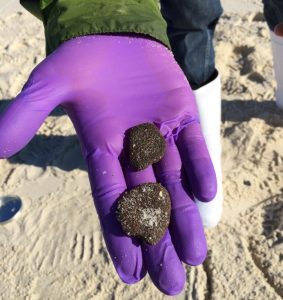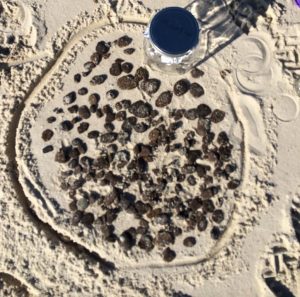Study Assesses How Sunlight and Microbial Degradation Affect Oil-Derived Sand Patties
– OCTOBER 13, 2017
Researchers analyzed the combined effects of photooxidation and biodegradation on sand patties associated with the Deepwater Horizon incident. The scientists found that irradiation contributed to increased concentrations of dissolved organic carbon, which leached from sand patties penetrated by seawater. The dissolved organic carbon was more susceptible to aerobic biodegradation compared to control treatments. These findings represent previously unrecognized advanced weathering processes that are important to the ultimate transformation of spilled crude oil. The researchers published their findings in Environmental Science & Technology: Impact of photooxidation and biodegradation on the fate of oil spilled during the Deepwater Horizon incident: advanced stages of weathering.
The environmental weathering of oil can alter its composition and result in a chemical fingerprint significantly different from the crude oil released at the wellhead. This transformation generates partially oxidized compounds called “oxyhydrocarbons” that often wash ashore as sand patties, where they are further degraded by microbes and sunlight. This study advances our understanding about the long-term fate and environmental effects of oxyhydrocarbons deposited on beaches.
The team used a radiotracer (35SO4-2) to track how seawater penetrated into sand patties during and after 3 to 12 hours of artificial sunlight exposure (equivalent to 0.75 to 3 days of average sunlight in the northern Gulf of Mexico) and in control treatments (non-irradiated or dark). Then, using Fourier Transform Ion Cyclotron Resonance Mass Spectrometry and a variety of optical measurements, the team characterized the sand patty-derived organic matter and both before and after biodegradation experiments.
The radiocarbon tracer penetrated readily into the sand patties, despite the expectation that the residual hydrocarbons might be hydrophobic and resist water penetration. The composition of dissolved organic material that leached into seawater did not inhibit microbial respiration. Rather, microbial oxygen consumption was significantly higher in irradiated treatments than controls, suggesting that photooxidation accelerates the aerobic degradation of dissolved organic material.
Study author Joseph Suflita explained more about the residual products from advanced weathering, “Spill weathering produces more polar and aqueous-soluble components that are far more difficult to detect and not routinely monitored [compared to hydrocarbons], and thus are a greater exposure risk to sea creatures and the public.”
Suflita said a growing body of evidence suggests that partially weathered hydrocarbon-derived components may be at least as inhibitory as the oil itself, but by different mechanisms. He advocates for improved methods to assess and measure this more subtle form of environmental contamination, “The quantitative importance, environmental fate, and toxicological impact of the thousands of partially oxidized oil-derived compounds that are leached during oil weathering processes to various environmental compartments are simply not known.”
Data are publicly available through the Gulf of Mexico Research Initiative Information & Data Cooperative (GRIIDC) at doi:10.7266/N75Q4T6B.
The study’s authors are Brian H. Harriman, Phoebe Zito, David C. Podgorski, Matthew A. Tarr, and Joseph M. Suflita.
************
This research was made possible in part by a grant from the Gulf of Mexico Research Initiative (GoMRI) to the University of New Orleans, Tulane University, and the University of Oklahoma for their project Effect of Photochemistry on Biotransformation of Crude Oil. Other funding sources included the National Science Foundation (DMR-1157490), the State of Florida, and the FSU Future Fuels Institute.
The Gulf of Mexico Research Initiative (GoMRI) is a 10-year independent research program established to study the effect, and the potential associated impact, of hydrocarbon releases on the environment and public health, as well as to develop improved spill mitigation, oil detection, characterization and remediation technologies. An independent and academic 20-member Research Board makes the funding and research direction decisions to ensure the intellectual quality, effectiveness and academic independence of the GoMRI research. All research data, findings and publications will be made publicly available. The program was established through a $500 million financial commitment from BP. For more information, visit https://gulfresearchinitiative.org/.
© Copyright 2010-2017 Gulf of Mexico Research Initiative (GoMRI) – All Rights Reserved. Redistribution is encouraged with acknowledgement to the Gulf of Mexico Research Initiative (GoMRI). Please credit images and/or videos as done in each article. Questions? Contact web-content editor Nilde “Maggie” Dannreuther, Northern Gulf Institute, Mississippi State University (maggied@ngi.msstate.edu).







